- Books Name
- A TEXT OF BIOLOGY - CLASS XII
- Publication
- ACME SMART PUBLICATION
- Course
- CBSE Class 12
- Subject
- Biology
HUMAN EVOLUTION
Place or origin of man :
It has been established that Dryopithecus is one of the oldest fossil which in turn evolved into apes and men.
The origin and evolution of man can be studied in the following three major headings : prior to ape men, ape men including prehistoric man and true men including the living modern man.
A. Prior to Ape Men
1. Dryopithecus. Discovery:
The fossil of Dryopithecus africanus was discovered from Miocene rocks of Africa and Europe.
It lived about 15 million years ago.
Dryopithecus and Ramapithecus were hairy and walked like gorillas and chimpanzees.
Ramaplthecus was more man like while Dryoplthecus was more ape like.
Dryopithecus is the direct ancestor of modern day apes.
Characteristics :
It was ape-like, but had arms and legs of the same length.
Heels in its feet indicate its semierect posture.
It had large brain, a large muzzle and large canines.
It was without brow ridges.
It was arboreal, knuckle-walker and ate soft fruits and leaves.
Dryopithecus africanus is regarded a common ancestor of man and apes (gibbons, orangutan, chimpanzee and gorilla).
It is also called proconsul.
2. Proconsul. Discovery:
Proconsul africanus or o. africanus was discovered by Louis S.B. Leakey in 1948 from the rocks around lake Victoria of Kenya, Africa.
It lived in early Miocene epoch.
Characteristics :
It was morphologically intermediate between apes and man in many features.
It had rounded man-like forehead and long, pointed ape like canines.
It moved upon land on all the four limbs and hence is not considered amongst the direct ancestors of man.
Proconsul gave rise to the ancestors of chimpanzee and gorilla in the Pliocene, about 4 million years ago.
The chimpanzee and gorilla diverged from each other only about 2.3 million years ago, in the Pleistocene epoch.
3. Sivapithecus. Discovery :
This fossil was discovered from middle and late Pliocene rocks of Shivalik Hills of India, hence it is named Shivapithecus.
Characteristics :
It was like Dryopithecus. Its fore limbs, skull and brain were like those of monkeys, while the face, jaws and teeth resembled those of apes.
4. Ramapithecus. Discovery:
It has been established that in late Miocene epoch, Dryopithecus gave rise to Ramapithecus ('Rama' =The hero of Indian legend, Pithecus =Ape) which was on the direct line of human evolution.
Ramapithecus survived from late Miocene to Pliocene.
Thus, he appeared about 14-15 million years ago.
Fossil of Ramapithecus was discovered by Edward Lewis (1932) from Pliocene rocks of Shivalik Hills of India.
Kenyapithecus wickeri was discovered by L.S.B. Leakey (1962) from Pliocene rocks of Kenya (Africa).
It was similar to Ramapithecus. But Ramapithecus was older than Kenyapithecus.
B. Ape-men Including Prehistoric Men
1. Australopithecus (First Ape-man) :
The early human stock gave rise to Australopithecus.
It is the connecting link between apes and man.
Discovery. Raymond Dart (1924), South African anthropologist, discovered the fossil of Australopithecus africanus (African Ape-man) from Pliocene rocks near Tuang in Africa.
They appeared about 5 million years ago.
Actually skull discovered by Dart was of 5-6 year old baby so it is also called "Tuang baby".
Some fossils of A. africanuswere also discovered from Pleistocene epoch.
Two mya, Australopithecines probably lived in east African grasslands.
Evidence shows they hunted with stone weapons but essentially ate fruits.
Characteristics :
Australopithecus africanus was about 1.5 metres high and had human as well as ape characters.
It was with bipedal locomotion, omnivorous diet and had erect posture.
It had human like teeth, but it had more of an ape brain than a human brain.
Its brain capacity was about 500 cc., similar to that of an ape.
He lived in caves.
Brow ridges projected over the eyes.
It did not have chin.
There was lumbar curve in the vertebral column.
The pelvis was broad. Australopithecus africanus existed until about 1.5 million years ago and gave rise to Homo habilis, about two million years ago.
Australopithecus africanus also gave rise to man-like apes called Australopithecus robustus and Australopithecus boisei along a separate line that ended blindly (They did not give rise to any other creatures).
In 1981 Donald Johanson, found a 3.2 million years old skeleton of a female human ancestor.
He nicknamed it Lucy.
Lucy's scientific name is Australopithecus afarensis.
Six species of Australopithecus are known.
These are A. africanus (African Ape man, Southern Ape or Tuang baby), A. afarensis, (Lucy), A. ramidus, A. aethiopicus, A. robustus and A. boisei. So we can say that Australopithecus had two main types.
(i) Gracile type: Australopithecus afarensis (Johanson) represented by fossil Lucy with small brain, small molar teeth pelvic girdles and short fingers like human.
(ii) Robust type: A. robustus had heavier body structure and massive check tooth (also called originally Paranthropus) cranial capacity -600cm2.
(Other examples -Zinjanthropus / A. boisei of R. Leakey -Africa, Meganthropus from -Java)
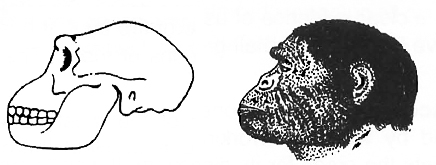
Skull and reconstructed head
2. Homo habilis (Able or Skillful man, The tool maker, or 'Handy man'). Discovery:
Louis S.B. Leakey and his wife Mary Leakey (1960) discovered the fossils of Homo habifis from Pleistocene rocks of Olduvai Gorge in East Africa.
He lived in Africa, about 2 million years ago.
The first human like being the hominid was Homo habilis. They probably did not eat meat.
Characteristics:
He was about 1.2 to 1.5 metres tall.
He had bipedal locomotion and moved erect.
It had about 650-800 cc. cranial capacity.
The teeth were like that of modern man.
Homo habilis (habilis = mentally able or skillful) was the first tool maker and used tools of chipped stones extensively.
It is also called handy man because heaps of tools found with these fossils included sharpened stones which indicate that Homo habilis was capable of 'making tools'.
He also led community life in caves and greatly cared for the young ones.
3. Homo erectus (Erect man) :
Homo erectus appeared about 1.5 million years ago, in middle Pleistocene.
Homo erectus probably ate meat.
He is called middle pleistocene man. H. erectus evolved from Homo habilis.
He was about 1.5-1.8 metres tall.
Homo erectus males were probably larger than females. He had erect posture.
His skull was flatter than that of modern man.
He had protruding jaws, projecting brow ridges and small canines and large molar teeth.
The cranial capacity was 900 cc.
Cranium was domed to accommodate the large brain.
He was omnivorous.
He made more elaborate tools of stones and bones, hunted big game and perhaps knew the use of fire.
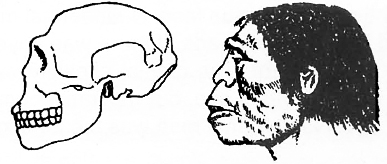
Skull and reconstructed head
Homo erectus includes three fossils : Java Ape-man, Peking man and Heidelberg man.
(a) Java Ape-man. Discovery:
In 1891, Eugene Dubois discovered a fossil from Pleistocene rocks in central Java (Island of Indonesia).
Eugene Dubois named it as Pithecanthropus erectus.
Pithecanthropus means 'ape man' Mayer in 1950 assigned it as Homo erectus erectus.
Characteristics :
Body 1.65 to 1.75 metres tall and weight about 70 kg.
Legs long and erect, but body slightly bent when moving.
Inconspicuous chin and somewhat broader nose.
Forehead low and receding, but brow ridges high, like those of apes.
Skull cap thick and heavy, flattened infront.
Cranial capacity 800 to 1000 ce. (average 950 cc).
Lower jaw large and heavy.
Teeth large, but quite like those of modem man, except larger canines of the lower jaw.
Lips thick and protruding.
He was omnivorous and cannibal.
Perhaps, he was the first prehistoric man to make use of fire for hunting, defence and cooking.
(b) Peking Man. Discovery:
W.C. Pei (1924) discovered the fossils of Peking man from the lime stone caves of Choukoutein near Peking (Beijing -capital of China was formerly known as Peking) and named them Sinanthropus.
Davidson Black (1927) named it Sinanthropus pekinensis.
Mayer (1950) renamed it as Homo erectus pekinensis (a subspecies).
The Pleistocene rocks from which fossils of Peking man were excavated are about 6 lakh years old.
Characteristics :
Placing Java ape man and Peking man as subspecies of Homo erectus has a sound basis, because of close similarities between these.
The body structure was quite similar in both.
Being about 1.55 to 1.60 metres tall, Peking man was slightly shorter and a little lighter and weaker.
The only noticeable difference of Peking man from Java ape man was its large cranial capacity, which ranged from 850 to 1100 cc.
Like Java ape man, the Peking man was omnivorous and cannibal.
There is a clear evidence of use of fire by it.
It has been confirmed that both Java and Peking men used to live in caves in small groups or tribes.
The tools of Peking man were relatively more sophisticated.
(c) Heidelberg man. Discovery :
In 1908 one of the most perfect fossil jaws belonging to middle Pleistocene was found by workmen working near Heidelberg, Germany.
It was shown to Otto Schoetensack, who gets the credit for its discovery. It was named Homo erectus heidelbergensis.
Characteristics :
It had lower jaw with all the teeth.
The teeth were human like.
The massive jaw was ape-like.
He used the tools and fire.
The cranial capacity is believed to be about 1300 cc; which is intermediate between those of erect man (H. erectus) and Neanderthal man (H. sapiens neanderthalensis).
Thus, it is regarded as intermediate between pithecanthropines and Neanderthals.
C. True Men Including the Living Modern Man
1. Neanderthal Man (Homo sapiens neanderthalensis). Discovery:
Fossils of Neanderthal man were first obtained from Neanderthal Valley in Germany from the late Pleistocene epoch by C. Fuhlrott (1856).
Later, many other fossils were excavated in various countries by different palaeontologists.
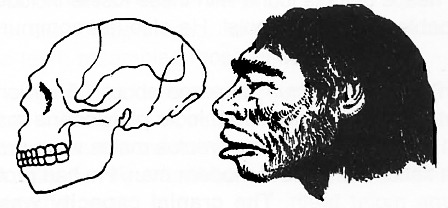
Skull and reconstructed head
Characteristics:
He had slightly prognathous face.
Neanderthal man walked upright, as we do, and had low brows, receding jaws, and high domed heads.
If there was anything truly different about them, it was that they were much stockier than we are.
The cranial capacity was 1,300 to 1,600 cubic centimetres.
Neanderthal man existed half a million years ago, but was most numerous from about 100,000 years ago.
Became extinct 30,000 years ago.
Neanderthal man was the legendary cave dweller, having heavy brow ridge and humped back.
He was adapted to a cold environment, who encountered a succession of glaciers that passed over most of the northern temperate regions of the world.
He was not only skilled hunter but true predator, a specialization that did not occur among hominids before or after them.
The Neanderthal man was cannibal and fashioned the skin into clothing to protect himself against the harsh climate.
Natural caves became campsites that were illuminated and heated by fire.
It is believed that he buried his dead with flowers and tools. He may have had a religion.
It is usually considered that Homo sapiens neanderthalensis did not evolve into Homo sapiens.
2. Cro-magnon man (Homo sapiens tossilis). Discovery:
It has been known as Cro-Magnon man, because its fossils were first discovered in 1868 from Cro-Magnon rocks of France by MacGregor.
Cro-Magnon man emerged about 34,000 years ago in Holocene epoch.
Thus, he is regarded as most recent ancestor of today's man.
Characteristics:
The Cro-Magnon man had, like us, about 1.8 metres tall, well-built body.
His face was perfectly orthognathous with an arrow, elevated nose, braad and arched forehead, moderate brow-ridges, strong jaws with man-like dentition, and a well developed chin.
His cranial capacity was, however, somewhat more than ours, being about 1650 cc.
It is, therefore, believed that Cro-Magnon man was somewhat more intelligent and cultured than the man of today.
It could walk and run faster and lived with families in caves.
It made excellent tools and even ornaments, not only of stones and bones, but also of elephant tusks.
Its tools included spears, bows and arrows, as he was omnivorous.
Use of the skin clothes by this man is also confirmed.
A number of cave paintings done by Cro-Magnon man have been discovered.
The Cro-Magnon man was the direct ancestor of the living modern man.
Prehistoric cave art developed about 18,000 years ago.
3. The Living Modern Man (Homo sapiens sapiens). Discovery :
Further evolution of man after Cro-Magnon involves the evolution of culture rather than that of anatomy.
Homo sapiens sapiens appeared about 25,000 years ago in Holocene epoch and started spreading all over the world about 10,000 years ago.
Agriculture came around 10,000 years back and human settlements started.
MODERN HUMANS
Homo sapiens
The evolutionary journey to modern humans ends with the appearance, about five hundred thousand years ago, of Homo sapiens ("wise man"), our own species.
We are newcomers to the human family -H. sapiens has not been around nearly as long as H. erectus was.
Still, humans have changed quite a bit, since those first days.
Concept Builder
Out of Africa -Again
The origin of human races is a much-debated point among scientists studying human evolution.
Many argue that the different races evolved from H. erectus independently, and that each adapted to a different place -Orientals in Asia, Caucasians in Europe, Aborigines in Australia, and so on.
Others believe that the same species would be unlikely to evolve more than once and argue that human races appeared after H. sapiens evolved from H. erectus.
Recently, scientists studying mitochondrial DNA from living humans all over the world have argued that their research shows that all human races originated from one H. sapiens ancestor in Africa.
Scientists looked at mitochondrial DNA to study evolution, because the DNA within mitochondria is transmitted only by females.
Female's eggs carry many mitochondria within them that become part of a new baby, while sperms contribute no mitochondria to the new baby.
Sperms carry their mitochondria wrapped around their tails and so do not inject them into the egg during fertilization.
For that reason, particular versions of a mitochondrial gene can be traced back through a family tree, from mother to grandmother to great-grandmother.
Human races evolved only recently in the evolutionary scale of things, and there has not been enough time for many mitochondrial DNA differences to accumulate, so the exact human tree cannot be reliably traced using this approach.
So far, however, the greatest number of different mitochondrial DNA sequences occur among modern Africans.
Since DNA accumulates mutations over time, the oldest DNA should show the largest number of mutations.
This result thus argues, that humans have been living in Africa longer than on any other continent.
While researchers are not in complete consensus, this line of investigation appears to suggest that H. sapiens evolved in Africa and that the human races evolved after that, and not independently from separate species of H. erectus.
If this Is correct, then H. sapiens was born in Africa and from there spread to all parts of the world, retracing the path taken by H. erectus half a million years before.
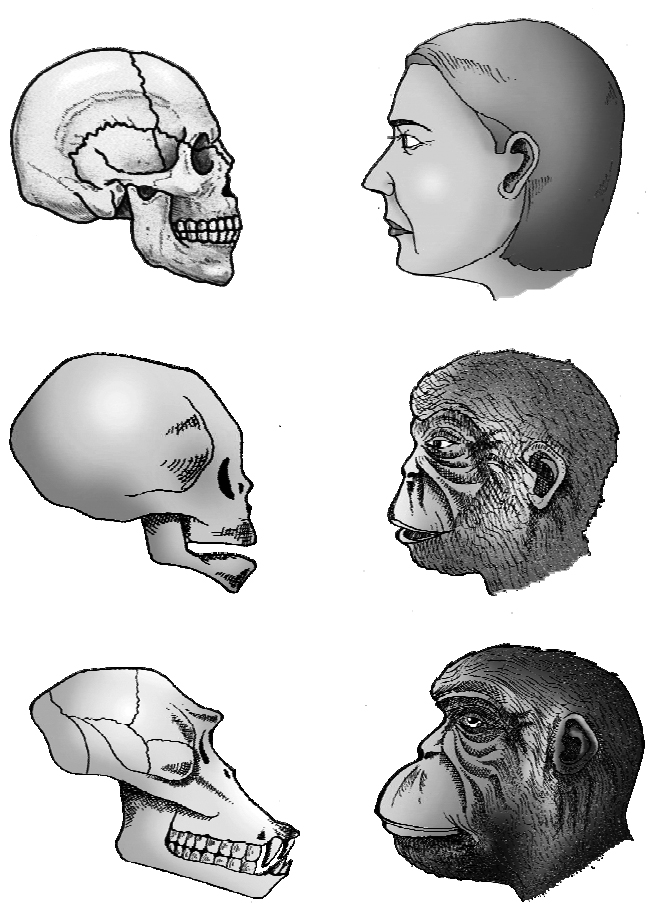
baby chimpanzee and adult chimpanzee. The skull of baby chimpanzee is
more like adult human skull than adult chimpanzee skull
Homology In Chromosomes of Man and Great Apes
The somatic cells of humans contain 46 chromosomes (44 autosomes and 2 sex- chromosomes).
Human chromosomes are usually obtained by culturing certain types of white blood cells from the peripheral blood.
They can then be treated with specific stains to produce characteristic bands along the length of each chromosome.
The pattern of banding so obtained is unique for each pair of chromosomes.
Banding techniques enable the identification of individual chromosomes and their parts.
The diploid number of chromosomes in gorilla, chimpanzee and orangutan is 48.
Comparisons have been made between banded chromosomes of man and those of the great apes.
The total amount of DNA in human diploid cells and that of the great apes are not dissimilar.
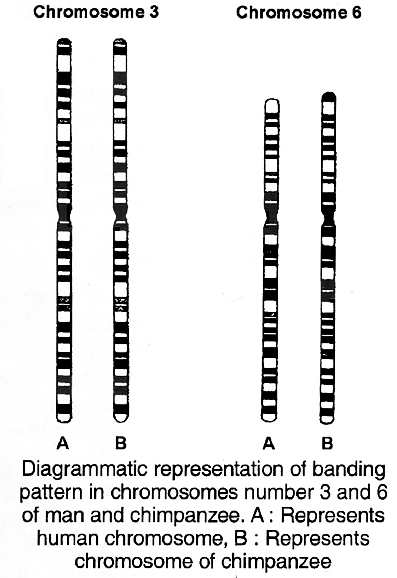
But what is most interesting from an evolutionary viewpoint, is that the banding pattern of individual human chromosomes is very similar and in some instances, identical to the banding pattern of apparently homologous chromosomes in the great apes.
Diagrammatic representations of the banding pattern of human chromosome numbers 3 and 6 are compared with those of particular autosomes in the chimpanzee.
This remarkable similarity in the fine structural organisation of the chromosomes is understandable only in terms of a common origin for man and chimpanzee.
Concept Builder
Cope's Law: It states that there is a tendency for animals to increase in size during the long course of evolution.
Bergman's Law : It states that warm blooded animals become larger in the northern and colder parts of their range.
Allen's Law : It states, that in animals which live in very cold climates, their extremities such as ears, tails etc. become progressively smaller.
Gause's Law: (Gause, 1934) or the Competitive exclusion Principle (Hardin, 1960). It states that two species having the same ecological requirements cannot continue to occupy indefinitely the same habitat.
Gloger's rule: It states that among warm blooded animals, those living in warm and moist climate develop more melanin pigment (are darker than animals in cold, dry climates) whereas forms in dry, hot climates have more yellow and red pigment.
Jordan's rule: Temperature also influences the morphology of certain fishes and is found to have some relation with the number of vertebrae. Fishes inhabiting water of low temperature tend to have more vertebrae than those of warmer water.
Some Important Points
1. Mars has CO2, water vapours and supposed to have life. CO2 is present in traces. It has no green house effect, hence it is very cold and does not support life. Mercury and moon do not have any sign of life due to the absence of water vapours. This extra terrestrial origin of life was visualised by Hoyle and Wickremsinghe.
2. Darwin used the term 'warm little pond' for early hot sea, rich in biomolecules. These primitive seas were alkaline.
3. K. Bahadur exposed ammonia, formaldehyde, and ferrous chloride to strong sunlight and obtained a mixture of amino acids called Jivam.
4. Variation In behaviour -Cicada insect has a life span of 17 years and it emerges from soil, remains alive for 5 weeks and then dies after mating and laying eggs. Dolphins can imitate and laugh. Bat can detect small insects of size (o.oa mm). Male baya (weaver's bird) of India builds its elaborate nest and decorates it with colourful petals to attract female.
5. Multiformity among organisms -Internal differentiation increases with the progress in evolution. Human beings are one of the most recently evolved animals. They show the following features :
(a) Total length of blood vessels in our body is 96,000 km.
(b) Fastest nerve impulse travels at the rate of 532 km per hour.
(c) Internal area of our lungs is 93-100 m2 which is 40 times than the external surface area of our body.
(d) Human brains have 10,000 million nerve cells.
(e) We have more body hair than apes but shorter and softer.
(f) O2 disappears from atmosphere at 16 km height.
(g) We remain blind for 30 minutes per day by blinking our eyes.
(h) Bones are as strong as concrete and as hard as granite but far lighter than both.
(i) We retain only 18% of total that we learnt yesterday.
6. Synapsid reptiles were mammal like reptiles that gave rise to mammals. They had a single temporal fossa on the lateral side of skull and heterodont teeth. They are extinct. They originated in Permian period.
7. In 1858 Dr. P.L. Sclater divided for first time the earth into six regions (realms) according to the distribution of birds. Later on Alfred Russel Wallace (1876) classified the earth into six regions (realms) for all animals and plants.
8. In all animals, early development is similar i.e., passes through morula blastula gastrula stages, showing their common origin.
9. Early embryos of all the vertebrates show basic similarity in having somites, tail, gill clefts, notochord etc. These traits can be explained as a character of evolution.
10. Any vertebrate organ also passes through different stages during development. e.g., mammalian heart is initially two chambered, then becomes three chambered and then becomes four chambered.
Development of all triploblastic animals starts from zygote, undergoes similar changes to form gastrula having 3 primary germ layers (ectoderm, mesoderm and endoderm) which have same fate in organogenesis. Early embryos of different vertebrates resemble in possessing similar structures like gill slits, notochord, tail etc. Not only this, in the course of development, at different stages, an embryo looks like the embryo of different phyla form, which the given organism has evolved.
It can be explained on the basis of Recapitulation theory (Von Baer) / Biogenetic law (Haeckel) which states that "ontogeny (developmental history of an individual) repeats phylogeny" (developmental history of race).
11. Types of fossils
(i) Macrofossils: Larger than 1 cm in size.
(ii) Unusual fossils: Sudden preservation of entire organism e.g., Solenhofen Limestone quarry of Southern Germany -containing fossils of Archaeopteryx.
(iii) Bioclast: Fossils or fragments of fossils enclosed in sediments. The term is usually applied to thin sections of fossils under microscope.
(iv) Gastroliths: These are found in abundance in the body cavities of certain reptiles.
(v) Moulds and casts: The material surrounding the fossil hardens and preserves the outer details. The actual bodies diSintegrate and are removed by slippage of the ground leaving the harden cavities called moulds. When moulds are filled with natural deposits, they are·called as casts e.g., fossils of Pompeii city buried in volcanic ash of mount Vesuvious in A.D. 79.
(vi) Tracks and trails : The footprints or tracks left in the soft moist mud gets hardened up e.g., tracks of amphibians discovered near Pittsburg, Germany from Pennsylvanian period.
12. Preservation in ice : Woolly mammoths from Siberia. The flesh is so well preserved that it can be fed to dogs. Discovered from Lena delta in 1790 and Siberia in 1901.
13. Fossils in petroleum springs and asphalts : Rancho La Brea now in Los Angeles.
14. Fossils in resins and ambers: Fossil fly in amber from Baltic forests of Europe during Oligocene period.
15. The process of fossilization to preserve the finer details is known as histometabasis.
16. Mummies: Bodies of dead animals or plants become dehydrated in the deserts and are preserved as mummies.
17. T. Dobzhansky wrote the book 'Genetics and origin of species'.
18. Darlington wrote the book 'The evolution of genetic systems'.
19. Darwin wrote 'Descent of Man and Selection in relation of sex' in which he put forward his theory of evolution of man from ape like ancestors.
20. Law of Superposition : The lower strata of a geological formation was first to be deposited and is the oldest.
21. Willston's Rule : During evolution of lineage, serially homologue parts tend to reduce in number but get more and more differentiated e.g., prawn's leg.
22. Allometry: The study of differential growth rate was called allometry.
23. Missing links : The fossils which act as transition between two present day groups of organisms ego Archaeopteryx -a fossil of crow sized toothed bird act as a link between reptiles and birds.
24. Empedocales (493 -435 B.C.) -regarded as "Father of the Concept of Evolution".
25. Seymouria (Extinct Reptile) is a connecting link between amphibia and reptilia.
26. Lycaenops (Extinct Reptile) is a connecting link between reptiles and mammals.
27. Wallace's Line: In 1863 A.R. Wallace drew an imaginary dividing line on the map between the Oriental and Australian realms (regions). This line is known as Wallace's line.
28. Sibling species: Species which are morphologically looking similar but are reproductively isolated, are called sibling species.
29. Living Fossils: A living fossil is a living animal of ancient origin with many primitive characters. A living fossil has been living as such from the time of origin without many changes.
30. Eugenics: It is the branch of science which deals with improvement of human race genetically. It can also be divided into two types : Negative eugenics and Positive eugenics. Under negative eugenics, people with inferior and undesirable (dysgenic) traits are prevented from reproducing.
31.
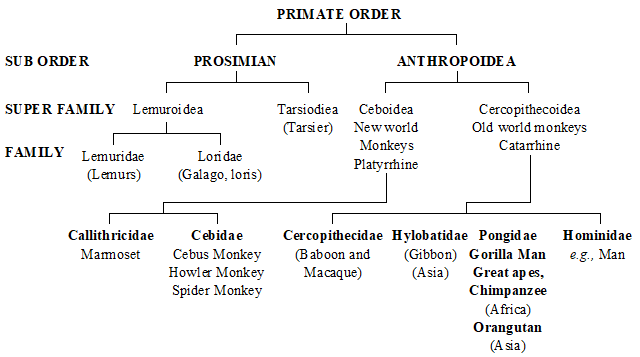
32. Homo sapiens or modern man is a member of the order primate, sub-order Anthropoidea. Primates have supposed to have evolved from primitive, tiny, insect eating quadruped, similar to modern tree shrews, which lived between 75 and 60 MYA during Eocene period. These belong to order Insectivora. Two evolutionary lines diverged leading to present day prosimians (treeshrews, lemurs, loris and tarsier) and the Anthropoidea (including old world and new world monkey, Ape and man)
33. The first (Ape + Man) ancestor originated in Oligocene period 30-35 MY A under the name Propliopithecus. (Fayiim deposits of Egypt). It is represented by fossil jaws and teeth. Aegyptopithecus is contemporary of Prppliopithecus (Kahira).
34. Dryopithecus -The Oligocene ancestor gave rise to Miocene group of (Apes + Man) called Dryopithecus (formerly known as proconsul). It lived in Africa and Asia. It had semi-erect posture with hind limbs and fore limbs of the same size. Hands and skull were monkey like, fore head like humans, jaw and dentition like apes. Shivapithecus discovered by Chopra Simon team is another fossil ape from Shivalik hills in India (derived from Dryopithecian stock).
An aberrant branch from Oryopithecus evolved in late Miocene early Pliocene, Oreopithecus which later on became extinct. Ramapithecus (= kenyapithecus) 14-15 MYA few teeth and fragments of jaw. Believed to have evolved from Dryopithecus in Shivalik hills in India during late Miocene and early Pliocene.
35. Gremaldi -From caves in a village Grimaldi on the Mediterranean coast, cranial capacity 1655 cc., believed to have given rise to Negroid stock.
Chancelade -Rock shelter near chancelede in Dordogne France, Cranial capacity -1450 cc., gave rise to Modern Eskimos.
36. Modern Man -H.sapiens sapiens evolved about 25,000 years ago but spread to various parts of world about 10000 -11000 years ago. There is thining of skull bones, slight reduction in cranial capacity (1400 -1450 cm3), four flexors in vertebral column and slight raising of skull cap. Modern man underwent cultural evolution. Paleolithic (age of tools of stones, bones, cave paintings). Mesolithic (age of animal husbandry, development of language reading and writings). Neolithic (development of agriculture, manufacture of pottery and clothes). Bronze age followed by iron age.
Forgery of Piltdown Man (Eoanthropus dawsoni) Charles Dawson in 1921 reconstructed the skull from the cranium of modern man and lower jaw of ape. The fossil skull known as Piltdown, the English hamlet where it was found.
37.
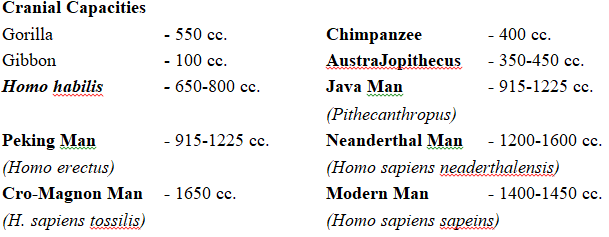
38. Transitional forms connecting Home erectus with Homo sapiens have been uncovered from Europe -Steinheim skull (Germany) Swanscombe skull (2nd Interglacial period) Fontechvade skulls (France 3rd Interglacial period) Ehringsdore skull. The above all are called as early H.sapiens.
The course of evolution of man started in Africa.

 ACME SMART PUBLICATION
ACME SMART PUBLICATION
